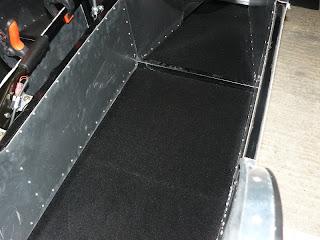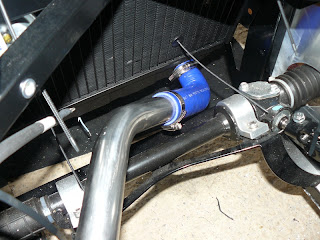First job was to fit the battery tray panel. I had already fitted the battery tray to the panel but had held off fitting it to the car until I was pretty sure I didn't need any access underneath it. It was a simple task of lining it up and drilling some 3.2mm holes, de-burring and cleaning, laying a bead of silicone and fitting in place. Here it is, job done.
Next I fitted the scuttle back on the car and started to bolt things on to it like the fuse box and the ECU. It is all going to be a bit tight behind the dash so it will need a bit of careful thought as to where the wires are routed. I had hoped the scuttle would now be finally fitted but I have a feeling it will need to come of again, or at least loosened to get the dash fitted.
Talking of the dash, I have been trying to decide on the final colour of the car and, accordingly, the dash colour. My Son in Law has offered to paint the car for me but he is snowed under with work and family commitments so I don't feel now is a good time to be asking this favour of him. I can always get it done another time. Anyway, this means that I am going to leave the car white/aluminium but as I have gone for magnolia dials, I didn't think the dash would look right white as well. Having seen a couple of others cars with carbon dashboards, I decided this was the way to go.
Now I wasn't about to spend £100 on a proper carbon dash when I have a perfectly good GRP one to work with. I bought some 3M carbon covering and have used that. The only other thing I had to buy was a hair dryer and that cost all of £8.99 from Tesco.
I cleaned up the GRP and set about laying on the carbon covering. The flat surface was fine but doing the curved parts was more of a challenge. This is where the hair dryer is invaluable. You heat up the carbon covering and it turns in to a much more pliable material allowing it to be molded round the complex curves. As it cools down it hardens up and retains the shape. Below you can see me working my way round the back of the dash.
And here is the finished product, with the holes for the instruments and warning lights cut out. There are still a couple of little bits to tidy up but this will all be hidden by the instruments and the stainless trim. I must say that I am pretty pleased with the finished result.
And with the surround. This deals with the warning lights a lot better and would just end up with a proper T shaped cover for the warning lights that displays the little symbols with the right colours.
Talking of the warning lights, as you can see from the dash above, I have opted for the all in one T shaped lights. I have also gone for the plug and play instrument loom from GBS. The only problem was that there was a socket for the warning lights but no little loom to join it with. A quick call to GBS and Ben came to the rescue. I sent him the loom and the T module and he made me up a loom, and a nice job he made of it too. It was all back to me within a week and all for a very reasonable cost. Here is the instrument loom and the warning light loom.
So that is it for a couple of weeks now due to Christmas and New Year. I am aiming to have the car ready to go to the factory for the IVA check over and then the test its self by the end of March. Only time will tell if I can stick to that deadline.
























































